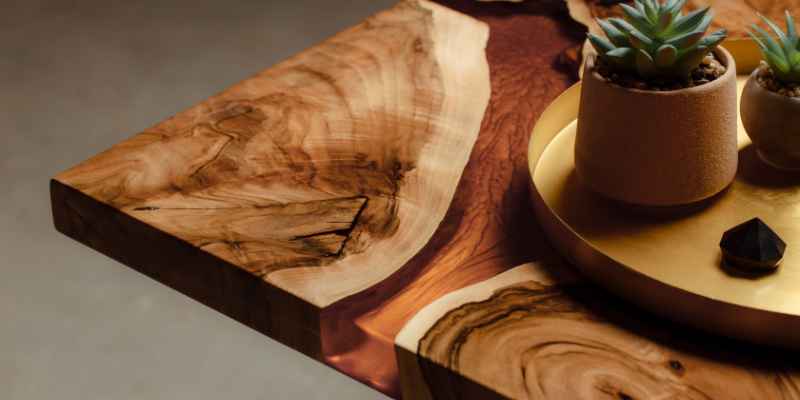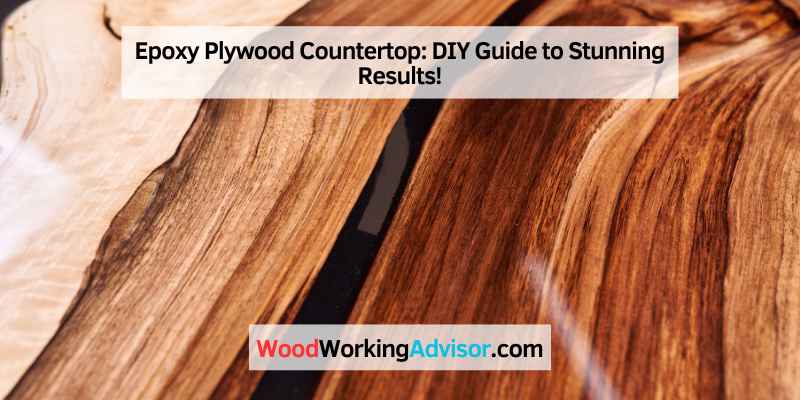Epoxy Plywood Countertops can transform your kitchen or bar top into a durable and unique work of art. By following a few simple steps, you can create a stunning countertop that resists heat, water, and stains, and lasts for years to come.
When looking to upgrade your kitchen or bar top, epoxy plywood countertops are a great option. Made by pouring a layer of clear epoxy over a wooden base, these countertops are both durable and unique. The process involves preparing the wooden base by sanding it down and sealing it to prevent bubbles from forming in the epoxy.
Once the epoxy is poured, it cures to a hard, glass-like finish that can resist heat up to 266°F and be cleaned with mild soap and water. Additionally, epoxy plywood countertops can be customized with different colors, textures, and designs to perfectly match your style.
Preparing The Surface
Before applying epoxy to a plywood countertop, it is important to prepare the surface properly. This includes sanding the plywood to ensure it is smooth and free of imperfections, as well as cleaning it thoroughly to remove any dust or debris.
Following these steps will ensure a successful and long-lasting epoxy countertop.
Selecting The Right Plywood And Tools
One of the crucial steps in preparing the surface for an epoxy plywood countertop is selecting the right plywood and tools. When selecting the plywood, ensure that it is at least 3/4 inch thick and made of good quality wood that is free of knots, warps, or defects. You can use a circular saw or a tablesaw for cutting the plywood, but make sure you wear safety goggles and earplugs.
Sanding And Cleaning The Plywood Surface
After selecting the right plywood, the next step is sanding and cleaning the surface. Sand the plywood surface with 80-grit sandpaper to remove any rough edges or splinters. Then, clean the surface thoroughly with a damp cloth to remove any dust or debris. Allow the surface to dry completely before proceeding to the next step.
Cutting And Fitting The Countertop
The final step in preparing the surface for an epoxy plywood countertop is cutting and fitting the countertop. Measure the dimensions of the countertop and mark the cutting line on the plywood using a pencil and a straightedge. Then, cut the plywood to size using a circular saw or a tablesaw. Once the plywood is cut to size, fit the countertop exactly into the desired location to make sure it fits snugly. You can also use clamps to hold the plywood in place while fitting it.
In conclusion, preparing the surface is a crucial step in installing an epoxy plywood countertop. By selecting the right plywood and tools, sanding and cleaning the surface, and cutting and fitting the countertop, you will ensure a clean and durable surface for the epoxy to adhere to.

Creating The Edge
Create a stunning and unique look for your countertops with an epoxy plywood design. With a variety of options such as live edge, faux marble, and concrete, you can transform your kitchen island or bar top into a work of art.
Check out DIY tutorials and premium clear epoxy products to achieve the ultimate cost savings and modern twist to your home decor.
Choosing The Edge Profile
When it comes to creating an edge for your epoxy plywood countertop, there are many different edge profiles to choose from. Some popular options include the bullnose, bevel, and ogee edges. It’s important to choose an edge profile that complements the style of your kitchen or bathroom.
Applying Bondo To Create A Rock Face Edge
To create a rock face edge on your plywood countertop, you’ll need to apply Bondo to the edge of the wood. Bondo is a filler that can be shaped and sanded to create a rough surface that resembles the texture of natural stone. Apply the Bondo to the edge of the plywood and use a trowel to shape it into the desired profile. Once the Bondo has dried, use sandpaper to smooth out any rough spots.
Sanding The Edge To Smooth It Out
After applying Bondo to create your rock face edge, it’s important to sand the edge to smooth it out. Use a fine-grit sandpaper and sand in a circular motion to ensure that the edge is smooth and free of any rough spots. Be sure to wear a dust mask and eye protection while sanding.
In conclusion, creating the edge for your epoxy plywood countertop is an important step in the installation process. By choosing the right edge profile, applying Bondo to create a rock face edge, and sanding the edge to smooth it out, you can achieve a beautiful and unique countertop that will add value to your home.
Masking And Taping
Learn how to create a beautiful and durable Epoxy Plywood Countertop with masking and taping techniques. Follow DIY tutorials on YouTube with expert advice on cutting, sanding, bonding, and painting techniques to achieve stunning results. Improve your DIY skills at home with cost-saving ideas and achieve a professional look with Stone Coat Countertops.
Masking The Sink Hole And Backsplash Area
Before starting the Epoxy Plywood Countertop project, protect the sink and splashback area by masking and taping them. Masking the sink hole and backsplash area is the first step towards achieving a perfect finish with your project.
Applying Tape To Protect The Surrounding Surfaces
The next step is to apply tape to protect the surrounding surfaces. Use painter’s tape and ensure that the surfaces around the area you want to epoxy are thoroughly covered. It is important not to skip this step, as it will prevent the epoxy from sticking to any area outside of the intended area. Applying tape around the sink and backsplash also creates a defined area for the epoxy to be poured into.
By masking and taping off the sink hole and backsplash area, the epoxy will be contained to only the target area, resulting in a clean and professional finish. Remember, prep work is key, and taking the time to mask and tape off surfaces will ensure the project’s success.
Applying Epoxy
Transform your plywood countertop with epoxy for a polished and durable finish. Using Stone Coat Countertops epoxy system, you can create a cost-effective and stylish alternative to traditional countertops. Follow expert DIY tutorials for a successful and unique result.
Mixing The Epoxy Resin And Hardener
The first step in applying epoxy to your plywood countertop is mixing the epoxy resin and hardener together. You can find epoxy resin and hardener kits at your local hardware store. Follow the instructions on the kit to ensure proper mixing. Mix the resin and hardener together using a drill with a mixing attachment or a stirring stick. Be sure to stir slowly and avoid creating bubbles.
Applying The Base Coat And Color Coat
The next step is applying the base coat and color coat. For the base coat, use a roller brush to apply a thin, even layer of epoxy to the entire surface of the plywood countertop. Allow the base coat to dry completely before moving on to the color coat. Apply the color coat by pouring the epoxy into a paint tray and using a roller brush to spread the epoxy evenly over the surface. You can add color pigment to the epoxy to achieve the desired color.
Pouring And Spreading The Final Coat Of Epoxy
The final step in applying epoxy to your plywood countertop is pouring and spreading the final coat of epoxy. Mix the epoxy resin and hardener according to the kit instructions and pour it over the entire surface of the countertop. Use a rubber squeegee to spread the epoxy evenly over the surface. Be careful not to leave any air bubbles or streaks. Allow the epoxy to dry completely, which typically takes about 24 to 48 hours. Once the epoxy is dry, sand the surface lightly with fine-grit sandpaper until it is smooth.
Conclusion:
In conclusion, applying epoxy to your plywood countertop is a great way to give it a beautiful and durable finish. Follow these steps to ensure a successful application process.
Finishing Touches
For a unique, rustic look, consider using epoxy to finish off your plywood countertop. With various colors and designs available, you can personalize your countertop to fit your style perfectly. Check out some DIY tutorials online for a cost-effective and impressive finished product.
Installing an epoxy plywood countertop is a creative and money-saving way to renovate your kitchen. Once the epoxy layer is applied on top of the plywood, it requires some finishing touches to complete the installation process. Here are some crucial steps you need to take to complete the process.
Removing Tape And Masking
After the epoxy is cured, remove the masking tape from the sides of the countertop. Scrape off any epoxy drips or bumps with a scraper. Sand the countertop with 80-grit sandpaper to level out the countertop and remove any unwanted textures. Progressively sand the countertop with finer grit sandpapers to smoothen the surface. Make sure to use a dust mask to avoid inhaling sanding dust.
Installing Sink And Cooktop
It’s time to install the sink and cooktop after achieving a smooth countertop surface. Place the sink and cooktop on top of the countertop, cut the plywood to match them, and create an accurate fit. Once they fit accurately, apply a waterproof sealant to the sink and cooktop’s edges, preventing water from penetrating the substrate.
Adding Backsplash And Splash Guard
After installing the sink and cooktop, add a backsplash and splash guard to the countertop. A backsplash is usually mounted to the wall behind the countertop, while a splash guard sits between the cooktop and the backsplash. You can install a splash guard by measuring and cutting the plywood to fit the cooktop, sand the edges of the plywood, apply a waterproof sealant, and add a layer of epoxy.
In conclusion, these steps should be followed carefully to add the perfect finishing touches to your epoxy plywood kitchen countertop. The process may require patience and attention to detail, but the result is well worth it. Once you’re done, enjoy your stunning and unique kitchen countertop that you designed and created yourself.
Polishing And Maintenance
To keep your epoxy plywood countertop looking great, regular polishing and maintenance is important. Be sure to avoid harsh chemicals and abrasive cleaners, and use a non-abrasive cloth or sponge to wipe down your countertop on a regular basis.
After creating your DIY Epoxy Plywood Countertop, it’s time to polish and maintain it to keep it looking its best. Achieving a high-gloss finish is possible by following the right steps. Here are two critical steps to take for polishing and maintenance of epoxy plywood countertop:
Sanding And Polishing The Epoxy Surface For A High Gloss Finish
Sanding and polishing the epoxy surface will give you the high-gloss finish you desire. Begin by sanding the surface with 220-grit sandpaper to remove any blemishes, bumps, or debris. Then, switch to a higher grit sandpaper, like 400 or 600, and continue sanding for a smoother surface.
Once satisfied, it’s time to polish the surface by applying a polishing compound. Use a soft, lint-free cloth to rub the surface and don’t forget to frequently change the cloth when it becomes dirty. Finally, buff the surface using a soft, dry cloth. Ensure that your workspace is free of dust or debris to achieve a perfect glossy finish.
Maintaining And Resurfacing The Epoxy Countertop
Maintaining and resurfacing the epoxy countertop is essential to prolong its life and keep it looking its best. To maintain the surface, avoid using harsh chemicals or abrasive cleaning tools. Instead, use a mild, non-abrasive soap and water solution, and wipe with a soft cloth. Never use vinegar, bleach, or ammonia on the surface, as they can damage the epoxy.
If you start noticing scratches or damage to the surface over time, then it’s time to resurface it. Resurfacing involves sanding the entire surface and applying a new layer of epoxy. You can choose to add different colors or designs to enhance the look of the surface. Remember to follow the steps for polishing after resurfacing for a pristine finish.
Conclusion
Polishing and maintaining your epoxy plywood countertop is crucial to keeping your investment looking new and polished. Make sure to follow the steps for sanding, polishing, and maintenance for a long-lasting surface. Additionally, you may need to resurface the surface after a while, since daily wear and tear are inevitable. With proper care, your epoxy plywood countertop will look great for years to come.
Disadvantages And Safety
While epoxy plywood countertops are a popular choice for homeowners and contractors, there are some potential disadvantages and safety concerns to consider before installation.
Toxicity And Safety Concerns Of Epoxy Resins
When working with epoxy resins for a plywood countertop, it is essential to adhere to all safety precautions and recommended practices. Epoxy resins contain chemicals that can produce harmful vapors, especially during the mixing and curing process, which may cause respiratory problems, skin irritation, and eye damage. Thus, it is crucial to wear protective equipment, work in a well-ventilated area, and follow the manufacturer’s instructions and precautions.
Disadvantages Of Epoxy Plywood Countertops
Even though epoxy plywood countertops are durable and add aesthetic value, they come with some inherent drawbacks. One of the significant downsides is that epoxy has minimal heat resistance, and thus, placing hot pots and pans may damage the surface. Similarly, it is challenging to make repairs once the epoxy has cured, as it requires the removal of the entire countertop layer. Additionally, epoxy plywood countertops can develop scratches, and their surfaces are not food safe unless sealed properly.
Conclusion
Therefore, it is crucial to consider the potential downsides and safety concerns of epoxy plywood countertops before making a final decision. If you decide to use them, make sure to follow safety instructions and precautions to minimize any health hazards and maximize their lifespan and functionality.

Frequently Asked Questions On Epoxy Plywood Countertop
Can You Epoxy Over Plywood For Countertops?
Yes, you can epoxy over plywood for countertops. It requires proper preparation of the surface, including sanding, priming and masking. DIY tutorials are available online to guide you on how to create the perfect epoxy countertop.
What Are The Disadvantages Of Epoxy Kitchen Countertops?
Epoxy kitchen countertops have several disadvantages, including toxicity, potential incompatibility with granite and marble, difficulty in handling, inconsistency, staining, and a cheap appearance.
How Do You Epoxy Resin Plywood?
To epoxy resin plywood for countertops, follow these steps:
1. Prepare the surface by sanding and cleaning it thoroughly.
2. Apply epoxy resin using a brush or roller.
3. Allow the first coat to dry completely before applying a second coat.
4. Sand the surface smooth and even.
5. Apply a clear coat for added protection.
How Do You Seal Plywood For Countertops?
To seal plywood for countertops with epoxy, you need to prepare the surface and tape off the area. Then, apply bondo to create a rock face edge and cut out a sink hole if needed. Mix and apply the epoxy, and use a torch to remove any air bubbles.
Finally, apply a clear coat for durability and natural sheen. Stone Coat Countertops offers a helpful DIY epoxy kitchen masterclass.
Conclusion
Creating an epoxy plywood countertop is a cost-effective way to upgrade your kitchen or bar top. With the right materials and techniques, you can achieve a beautiful, durable surface that resembles high-end materials such as marble or granite. DIY videos and tutorials are readily available to guide you through the process step-by-step.
Additionally, using SEO-friendly keywords such as “epoxy plywood countertop” can help your project gain visibility and attract more visitors to your website. So what are you waiting for? Get started on your DIY epoxy plywood countertop today!


